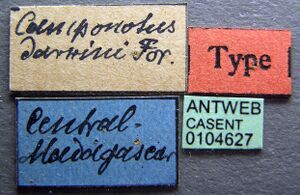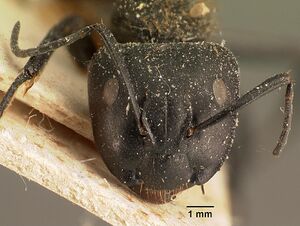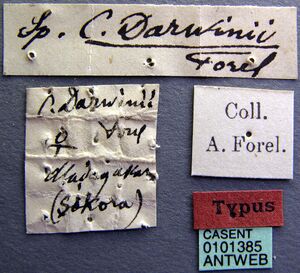Camponotus darwinii
| Camponotus darwinii | |
|---|---|

| |
| Scientific classification | |
| Kingdom: | Animalia |
| Phylum: | Arthropoda |
| Class: | Insecta |
| Order: | Hymenoptera |
| Family: | Formicidae |
| Subfamily: | Formicinae |
| Tribe: | Camponotini |
| Genus: | Camponotus |
| Subgenus: | Mayria |
| Species group: | darwinii |
| Species: | C. darwinii |
| Binomial name | |
| Camponotus darwinii Forel, 1886 | |
| Synonyms | |
| |
Occurs in a variety of habitats and is a common Camponotus in some areas of Madagascar.
Identification
Rasoamanana and Fisher (2022) - A member of the Camponotus darwinii species group. Body integument matte black, finely reticulate-punctate; mesosoma and/or gastral dorsum with dense, long, and yellowish pilosity and pubescence; anterior clypeal margin with short, rounded, rectangular lobe; petiole squamiform.
Camponotus darwinii should be separable from most similar species in this group by the combination of the following characters: presence of dense hairs on mesosoma and/or gastral dorsum, mandible and malar area distinctly reddish in color, propodeal and declivitous faces unequal in length. This species is much closer to Camponotus ursus but differs in the density of mesosomal hairs and the aspect of the petiole. In addition, C. darwinii is much more robust than C. ursus.
Keys including this Species
Distribution
Widely distributed across Madagascar, with a range extending from Ankazobe to Mount Papango. It has been collected at elevations ranging from 1070 to 2150 m.
Latitudinal Distribution Pattern
Latitudinal Range: -14.3° to -24.9°.
| North Temperate |
North Subtropical |
Tropical | South Subtropical |
South Temperate |
- Source: AntMaps, Rasoamanana & Fisher, 2022
Distribution based on Regional Taxon Lists
Malagasy Region: Madagascar (type locality), Seychelles.
Distribution based on AntMaps
Distribution based on AntWeb specimens
Check data from AntWeb
Countries Occupied
| Number of countries occupied by this species based on AntWiki Regional Taxon Lists. In general, fewer countries occupied indicates a narrower range, while more countries indicates a more widespread species. |

|
Estimated Abundance
| Relative abundance based on number of AntMaps records per species (this species within the purple bar). Fewer records (to the left) indicates a less abundant/encountered species while more records (to the right) indicates more abundant/encountered species. |

|
Habitat
Known from a variety of habitats, including rainforest, montane rainforest, Uapaca forest, and Uapaca woodland as well as disturbed habitats such as urban and garden areas and cultivated land (Tavy).
Biology
Camponotus darwinii has been found nesting in the plants Melia azedarach and Phellolophium madagascariense.
Castes
Worker
Images from AntWeb
   
| |
| Worker. Specimen code casent0101186. Photographer April Nobile, uploaded by California Academy of Sciences. | Owned by Natural History Museum, Basel. |
   
| |
| Worker (major/soldier). Specimen code casent0101386. Photographer Nick Olgeirson, uploaded by California Academy of Sciences. | Owned by MHNG, Geneva, Switzerland. |
   
| |
| Worker. Specimen code casent0101391. Photographer Nick Olgeirson, uploaded by California Academy of Sciences. | Owned by MHNG, Geneva, Switzerland. |
   
| |
| Type of Camponotus darwinii. Worker. Specimen code casent0104626. Photographer April Nobile, uploaded by California Academy of Sciences. | Owned by ZMHB, Berlin, Germany. |
   
| |
| Type of Camponotus darwinii. Worker. Specimen code casent0104627. Photographer April Nobile, uploaded by California Academy of Sciences. | Owned by ZMHB, Berlin, Germany. |
   
| |
| Worker. Specimen code casent0101194. Photographer April Nobile, uploaded by California Academy of Sciences. | Owned by NHMB, Basel, Switzerland. |
  
| |
| Worker. Specimen code casent0101195. Photographer April Nobile, uploaded by California Academy of Sciences. | Owned by NHMB, Basel, Switzerland. |
   
| |
| Worker. Specimen code casent0101378. Photographer April Nobile, uploaded by California Academy of Sciences. | Owned by MHNG, Geneva, Switzerland. |
   
| |
| Worker (major/soldier). Specimen code casent0101380. Photographer April Nobile, uploaded by California Academy of Sciences. | Owned by MHNG, Geneva, Switzerland. |
   
| |
| Worker. Specimen code casent0101392. Photographer April Nobile, uploaded by California Academy of Sciences. | Owned by MHNG, Geneva, Switzerland. |
  
| |
| Worker. Specimen code casent0101393. Photographer Nick Olgeirson, uploaded by California Academy of Sciences. | Owned by MHNG, Geneva, Switzerland. |
   
| |
| Type of Camponotus darwinii rubropilosus. Worker. Specimen code casent0104628. Photographer April Nobile, uploaded by California Academy of Sciences. | Owned by ZMHB, Berlin, Germany. |
   
| |
| Type of Camponotus darwinii rubropilosus. Worker (major/soldier). Specimen code casent0104629. Photographer April Nobile, uploaded by California Academy of Sciences. | Owned by ZMHB, Berlin, Germany. |
Queen
Images from AntWeb
   
| |
| Queen (alate/dealate). Specimen code casent0101385. Photographer Nick Olgeirson, uploaded by California Academy of Sciences. | Owned by MHNG, Geneva, Switzerland. |
Nomenclature
The following information is derived from Barry Bolton's Online Catalogue of the Ants of the World.
- darwinii. Camponotus darwinii Forel, 1886f: 179 (s.w.) MADAGASCAR.
- Type-material: lectotype minor worker (by designation of Rasoamanana & Fisher, 2022: 182), 5 paralectotype major workers, 1 paralectotype queen.
- [Note: queen caste is not mentioned in the original description.]
- Type-locality: lectotype Madagascar: “Centre de Madagascar” (no further data) (J.M. Hildebrandt); paralectotypes with same data.
- Type-depositories: MHNG (lectotype); MHNG, MNHU (paralectotypes).
- Combination in C. (Myrmobrachys): Forel, 1914a: 270;
- combination in C. (Myrmepomis): Emery, 1920b: 258;
- combination in C. (Myrmopiromis): Wheeler, W.M. 1922a: 1051;
- combination in C. (Mayria): Rasoamanana & Fisher, 2022. 147.
- Status as species: Forel, 1891b: 43 (redescription); Dalla Torre, 1893: 228; Emery, 1896d: 377 (in list); Wheeler, W.M. 1922a: 1051; Emery, 1925b: 128; Bolton, 1995b: 95; Rasoamanana & Fisher, 2022. 182 (redescription).
- Senior synonym of rubropilosus: Rasoamanana & Fisher, 2022: 183.
- Material of the unavailable name robustior referred to darwinii by Rasoamanana & Fisher, 2022. 183.
- Distribution: Madagascar.
- rubropilosus. Camponotus darwinii var. rubropilosus Forel, 1891b: 44 (s.w.) MADAGASCAR.
- Type-material: lectotype major worker (by designation of Rasoamanana & Fisher, 2022: 182), 3 paralectotype major workers.
- Type-locality: lectotype Madagascar: Imerina, forêt d’Analamainty, NE Antananarivo (P. Camboué); paralectotypes with same data.
- Type-depositories: MHNG (lectotype); MHNG, MNHU, NHMB (paralectotypes).
- Combination in C. (Myrmopiromis): Wheeler, W.M. 1922a: 1051.
- Subspecies of darwinii: Dalla Torre, 1893: 228; Emery, 1896d: 377 (in list); Forel, 1905b: 165; Forel, 1907g: 92; Wheeler, W.M. 1922a: 1051; Emery, 1925b: 128; Bolton, 1995b: 121.
- Junior synonym of darwinii: Rasoamanana & Fisher, 2022. 182.
Unless otherwise noted the text for the remainder of this section is reported from the publication that includes the original description.
Description
Worker
Rasoamanana and Fisher (2022):
Morphological measurements: see Appendix 1 and Ratios of morphometric data for majors and minors
Minor
Medium size. Absolute cephalic size (CS: 1.45±0.28; 1.22–1.63). In full-face view, head more quadrate (CWb/CL: 0.37±0.03, 0.35–0.41); posterior margin of head almost flat, lateral margin of head slightly convex and tapering to front. Eyes circular, placed midway from the occipital corner (PoOC/CL: 0.08±0.02; 0.06–0.09). Mandibles triangular with six teeth. With head in full-face view, anterior clypeal margin with a short, rounded, rectangular lobe; less convex in lateral view, not medially marginate (ClyL/GPD: 0.25±0.04, 0.23–0.28). Antennal scape circular and long, surpassing the occiput by the length of two basal funiculi (SL/CS: 0.40±0.04; 0.37–0.43). In lateral view, anterodorsal corner of pronotum rounded, mesosomal dorsal outline feebly and rather evenly arcuate above, dorsal face of propodeum generally longer than declivitous face (MW/ML: 0.21±0.02; 0.19–0.23; MPD/ML: 0.24±0.03; 0.20–0.26). In lateral view, petiolar node cuneate, anterodosum straight basally and inclined dorsally to reach the flattened posterodorsal margin. Tibia tubular, not prismatic, its extensor profile with suberect setae. Head dorsum is matte, finely reticulate-punctate with sparse punctures on malar area; mesosoma striate in lateral view; in dorsal view, petiole, mesosoma, and appendages less shiny, finely reticulate-striolate except the abdominal sternite, which is more matte. Mandible finely reticulate-punctate with sparse oblique punctures. Hairs yellowish white, orange, or tawny colored, erect hairs usually abundant, at least on gastral tergite, often on vertex, occipital portion, and thorax dorsum; petiolar node with 4 pairs of hairs on its dorsum. Shiny black, with mandible and basitarsus reddish to brownish.
Major
Characteristics of minor workers, except: head much wider posteriorly (CS: 2.14±0.26, 1.70–2.47; CWb/CL: 1.04±0.06, 0.94–1.20); lateral margins convex and converging towards base of mandible. Eyes semicircular, placed dorsolaterally midway from the occipital margin (PoOC/CL: 0.22±0.01, 0.19–0.24). Clypeus much more quadrate in full-face view (ClyL/GPD: 0.72± 0.09, 0.48–0.81), its anterior margin slightly concave medially. Antennal scape short, just surpassing the occipital border (SL/CS: 0.83±0.08, 0.75–0.99). Dorsal outline of mesosoma forms a continuous line so that the basal portion of propodeum forms an obtuse angle with the declivity. Lateral portion of head finely reticulate above, punctate to finely areolate below.
Type Material
Rasoamanana and Fisher (2022) - Camponotus darwinii Lectotype minor worker, present designation, Centre de Madagascar [Ambatomanjaka, Miarinarivo, –18.766947, 46.869107, 1343 m] (Hildebrandt), AntWeb CASENT0101391 (MHNG). Paralectotypes: one alate queen and five major workers, same data as lectotype, but specimen coded respectively as CASENT0101385 (queen) andCASENT0101386 (MNHG), CASENT0104426, CASENT0104427, FOCOL2468 and FOCOL2469 (ZMHB) (examined). Camponotus darwinii var. rubropilosus Lectotype major worker, present designation, Madagascar, Antananarivo (Camboué), AntWeb CASENT0101392 (MHNG). Paralectotypes: three major workers same data as the lectotype CASENT0101393 (MHNG), CASENT0104628 (ZMHB), CASENT0101193 (NHMB).
Camponotus darwinii r. rubropilosus var. robustior Lectotype minor worker, present designation, Toliara, Menabe, Beronono; Mahabo, –21.0, 45.0, 339 m (Woltzkow), AntWeb CASENT0104629 (MNHG). Paralectotypes: two major workers, same data as lectotype, but specimen coded respectively as CASENT0101195andCASENT0101380 (MHNG). [Antwiki note: Some of the musuem abbreviations given here are not listed in the cited publication's "Abbreviations of depositories."]
References
- Emery, C. 1920b. Le genre Camponotus Mayr. Nouvel essai de la subdivision en sous-genres. Rev. Zool. Afr. (Bruss.) 8: 229-260 (page 258, combination in C. (Myrmepomis))
- Forel, A. 1886h. Études myrmécologiques en 1886. Ann. Soc. Entomol. Belg. 30: 131-215 (page 179, soldier, worker described)
- Forel, A. 1891c. Les Formicides. [part]. In: Grandidier, A. Histoire physique, naturelle, et politique de Madagascar. Volume XX. Histoire naturelle des Hyménoptères. Deuxième partie (28e fascicule). Paris: Hachette et Cie, v + 237 pp. (page 43, see also)
- Forel, A. 1914a. Le genre Camponotus Mayr et les genres voisins. Rev. Suisse Zool. 22: 257-276 (page 270, combination in C. (Myrmobrachys))
- Rasoamanana, N., Fisher, B.L. 2022. A taxonomic revision of the Malagasy endemic subgenus Mayria of the genus Camponotus (Hymenoptera, Formicidae) based on qualitative morphology and quantitative morphometric analyses. ZooKeys 1081: 137–231 (doi:10.3897/zookeys.1081.71872).
- Wheeler, W. M. 1922k. Ants of the American Museum Congo expedition. A contribution to the myrmecology of Africa. IX. A synonymic list of the ants of the Malagasy region. Bull. Am. Mus. Nat. Hist. 4 45: 1005-1055 (page 1051, combination in C. (Myrmopiromis))
References based on Global Ant Biodiversity Informatics
- Fisher B. L. 1997. Biogeography and ecology of the ant fauna of Madagascar (Hymenoptera: Formicidae). Journal of Natural History 31: 269-302.
- Fisher B. L. 2003. Formicidae, ants. Pp. 811-819 in: Goodman, S. M.; Benstead, J. P. (eds.) 2003. The natural history of Madagascar. Chicago: University of Chicago Press, xxi + 1709 pp.
- Forel A. 1886. Études myrmécologiques en 1886. Annales de la Société Entomologique de Belgique. 30: 131-215.
- Ravelomanana A., and B. L. Fisher. 2013. Diversity of ants in burned and unburned grassland , and dry deciduous forest in the Beanka Reserve, Melaky Region, western Madagascar. Malagasy Nature 7: 171-183.
- Wheeler W. M. 1922. Ants of the American Museum Congo expedition. A contribution to the myrmecology of Africa. IX. A synonymic list of the ants of the Malagasy region. Bulletin of the American Museum of Natural History 45: 1005-1055

